- L1 Introduction
- L2 Concepts & Models
- L3 Cloud Architecture
- L4 Resource Hosting & Datacenter
- L5 Virtualization & Multi-tenancy
- L6 Applications and Paradigms
- L7 Example Applications
- L8 Cloud Service Development
- L9 Pricing Models and TCO
- L10
L1 Introduction
What is Cloud Computing?
On-demand service + Elastic resource
- Program is an Internet (cloud) service, and platform are datacenters
History
- 1996: First time name appeared.“ Cloud computing” was coined at Compaq Computer
- 1999: Salesforce.com pioneered the concept of delivering enterprise applications via a simple website
- 2002: AWS
- 2006: AWS S3, EC2, Google App Engine
- 2009: Microsoft Azure
Why?
Improves availability and elasticity(彈性)
Reduces business cost
Key terms
- Elastic resource
- Availability
- Capacity planning (Resource provisioning):
- determine and fulfill future demands of IT resources
- Strategies:
- Lead strategy: add capacity in anticipation of demand (before)
- Lag strategy: add capacity when resource reach its full capacity
- Match strategy: add capacity in small increments as demand increases
- Should avoid under-provisioning & over-provisioning
- If on-premise:
- IT department is a big cost
- Up-front investment costs + operational costs
- Organizational Agility(敏捷)
- organization’s responsiveness to change
- On-premise: costs may be prohibitive(令人卻步的)
- Cloud: Elastic IT resources
- Cloud based IT resources
- Scaling (horizontal, vertical):
- Horizontal: add same resource type (水平) e.g. add more servers
- Vertical: replace resource with higher/ lower capacity in a single node. (垂直) e.g. add an CPU to the server
- Horizontal easier/less expensive than vertical
- Cloud services:
- IaaS
- PaaS
- SaaS
- Overlapping of Trust Boundaries (not secure, increase security vulnerabilities)
Expansion of trust boundary: from own (own data own data + other company’s data on the same cloud)
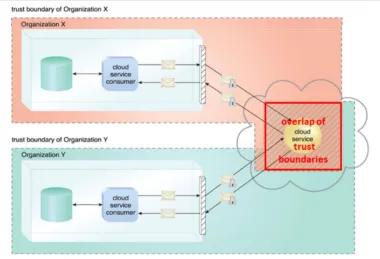
- Reduced operational governance control, privacy/ legal issues
- Data localization/ residency
L2 Concepts & Models
NIST 5 Essential Characteristics, 4 Deployment Models, 3 Service Models
5 Essential Characteristics
- On-demand (elasticity) self-service (via a service portal)
- Broad network access: ubiquitous access (must have good network)
- Resource pooling (management): location independent, multi-tenancy (多租戶)
- Multi-tenancy: An instance of the program serves multiple cloud consumers (by virtualization)
- Rapid elasticity: time to market/ fast deployment
- Measured service: pay-per-use billing
4 Deployment Models
- Public Cloud: available to the general public, shared by all consumers (most common)
- Private Cloud: used only by an organization (for enterprises with large scale IT) (can be on site or by a third party)
- Amazon VPC
- Community Cloud: shared by multiple organization based on common operational and regulatory requirements
- modified form of a private cloud
- Hybrid (Federated) Cloud: 2 or more public and private clouds that interoperate (flexibility)
- Multi-cloud: using two or more clouds from different cloud providers
- Sovereign Cloud (主權): Meet regulatory and compliance needs of a country, data only stays within national borders, prevents foreign access
3 Service Models
- Different levels of abstraction and management
- SaaS: uses provider’s application over a network/ browser (e.g. Google apps)
- user remotely runs the software provided on the cloud
- provider installs and maintains software
- highest level of abstraction
- PaaS: deploy customer-related applications to a cloud (e.g. Google’s app engine, Amazon AWS, Microsoft Azure)
- Platform software + computing resources
- IaaS: Rent processing, storage, network capacity … (e.g. Amazon EC2, DigitalOcean)
- Lowest level of abstraction (only abstract physical resources)
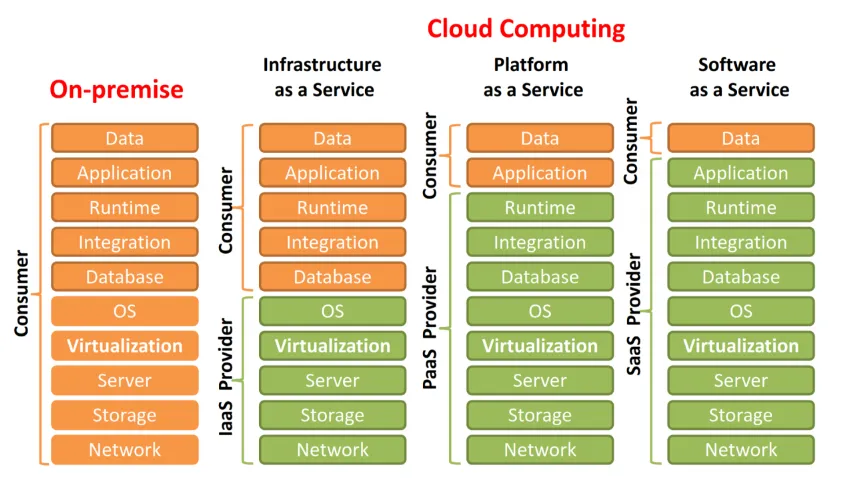

Cloud Computing Reference Architecture
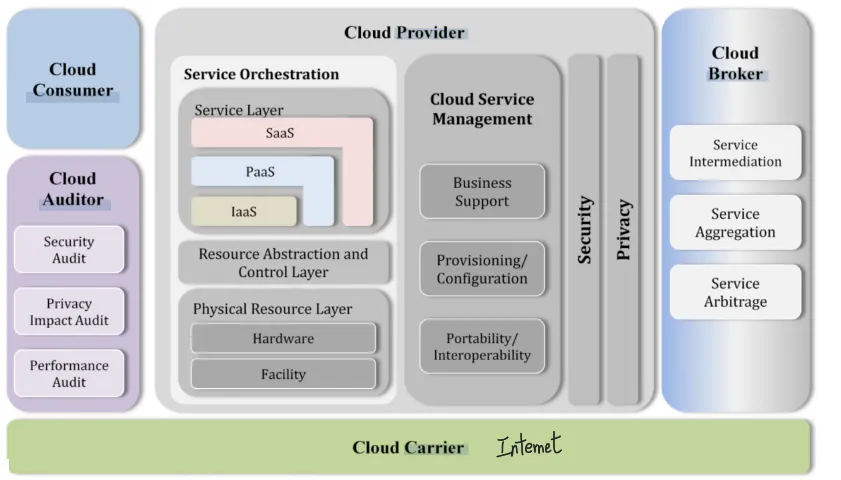
5 major actors
- Cloud consumer
- Cloud provider: 3 types: IaaS, PaaS, SaaS cloud provider
- Cloud auditor: conducts independent assessment of cloud services (稽查員)
- verify compliance with regulation and security policy
- Cloud broker (marketplace): negotiate the relationships between providers and consumers
- Service intermediation: provides value-added services
- Service aggregation: combines and integrated multiple services into one or more new services, data integration,
- ensure secure data movement between cloud consumers and multiple cloud providers
- Service arbitrage: flexibility to choose services from multiple agencies
- Cloud carrier: provides connectivity and transport of cloud services from providers to consumers
3 layers of service orchestration

L3 Cloud Architecture
Resource Organization
- to achieve elasticity and scaling
- to achieve balanced utilization of cloud resources
Workload Distribution Architecture
- distribute workload over available cloud resources use horizontal scaling (add more machines)
- Load Balancer distributes workload
- greater fault tolerance
- elastic load balancing: automatically distributes incoming traffic
- Types:
- Application LB: single point of contact for clients, contains one or more listeners
- Listener:
- checks for requests from clients using protocol & port defined
- user-defined rules, consist of priority, one or more actions, one or more conditions, default rule is necessary
- Steps:
- LB receives a request
- Request is evaluated and appropriate rule is applied
- Select a target from the target group for the rule action
- Listener:
- Network LB
- Gateway LB
- Classic LB
- Application LB: single point of contact for clients, contains one or more listeners
Resource Pooling Architecture
- aggregate cloud resources of different types to serve diverse needs
- maintain identical IT resources to ensure synced
- Types:
- Dedicated Pools: becomes complex
- CPU pool, memory pool, storage pool, network pool…
- Sibling Resource Pools:
drawn from physical grouped IT resources and not spread out across data centers
isolated from one another so each cloud consumer is given access to its respective pool
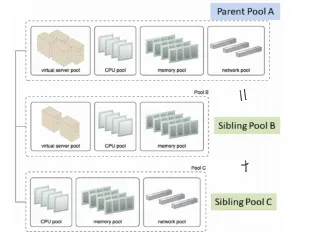
- Nested Resource Pool:
larger pools divided into smaller pools with same type of IT resources
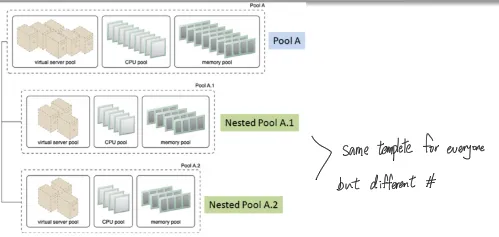
- Dedicated Pools: becomes complex
Dynamic Scalability Architecture
- enable variable resource utilization to meet usage demand fluctuations, based on predefined scaling conditions
- Types:
- Dynamic Horizontal scaling: same resource instance scaled dynamically
- Dynamic Vertical scaling: scale processing capacity of a single IT resource
- Dynamic Relocation: resource relocated to host with larger capacity
- Steps
- Automated scaling listener monitors capacity
- Listener takes decision baed on predefined scaling policy
- Listener replicates resources
Elastic Resource Capacity Architecture
- dynamic provisioning of virtual servers
- allocated and reclaims CPUs, RAMs, etc.
- runtime virtual server is monitored
- additional resources leveraged before capacity threshold reached
- virtual server and IT resources vertically scaled
- use Intelligence Automation Engine


Service Load Balancing Architecture
- redundant cloud service deployments are created with a load balancer to dynamically distribute workloads
- resource pool duplicated cloud service
- Types:
- Independent of cloud services and their host servers
- Build-In to cloud service as part of application or server environment
Scaling On-Premise Provisioning
- move things to the cloud if needed hybrid
- Burst-Out: to meet higher usage demand, scale to cloud
- Burst-In: on lower demand, revert back to on-premise
L4 Resource Hosting & Datacenter
- Latency: Time takes a packet to travel from one node to another. Important when small amount of data transfer, response time is key
- Bandwidth: # bits transferred per unit time. Important when large amount of data transfer
Datacenter components:
- main server hall: compute, storage, network
- Use commodity hardware with modular architecture
- servers server racks datacenter
- Rack: supports servers, storage & network equipment
- Top of Rack (TOR): has provision for power, battery & rack-level switch (connects IT resources within rack & rack to the datacenter)
- Rack-level switch: connects IT resources within rack and connects the rack to the datacenter network
- mechanical yard: host cooling system
- electrical yard: generators and power distribution
Storage:
- Types
- Private to individual running tasks: in local DRAM or disk
- Shared state of distributed workload
Network:
- Local Area Network (LAN): within a rack, redundant connectivity
- Storage Area Network (SAN): between servers and storage systems
Electricity Demand
- from air to water: water is 1000x more efficient than air
- Power Usage Efficiency (PUE): total power used by datacenter / power used by IT equipment (ideal PUE= 1)
- Energy Proportional Systems: energy efficiency is not a linear function
- Energy Proportional Systems consumes almost no power when idle, very little under light load, more power as load increases
Tiers:

L5 Virtualization & Multi-tenancy
Virtualization
- Enables a single physical infrastructure to function as multiple logical infrastructure or resource
- one-to-many
- improve resource utilization through sharing
- Pros:
- hardware independence
- resource consolidation (整合): increase hardware utilization
- resource replication (複製): rapid scaling as resources are virtual
- Cons:
- performance overhead (performance drops)
- single point of failure: virtualization software fails, everything fails
Types of virtualizations
- Processor virtualization
- Memory virtualization
- Storage virtualization
- Network virtualization: abstracting physical network components to form a virtual network
- Data virtualization: aggregates heterogeneous data from different sources to a single logical or virtual volume of data
- Application virtualization: allows users to access the virtual instance of hosted application without installation
Operation System Protection
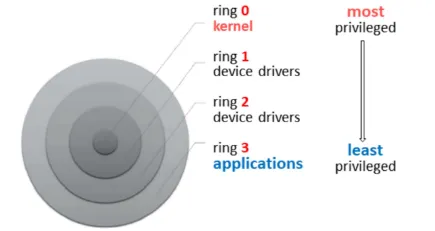
Virtualization Approaches
Virtualization software = hypervisor = virtual machine manager (VMM)
virtualization software (ring 0), guest OS (ring 3)
Full Virtualization
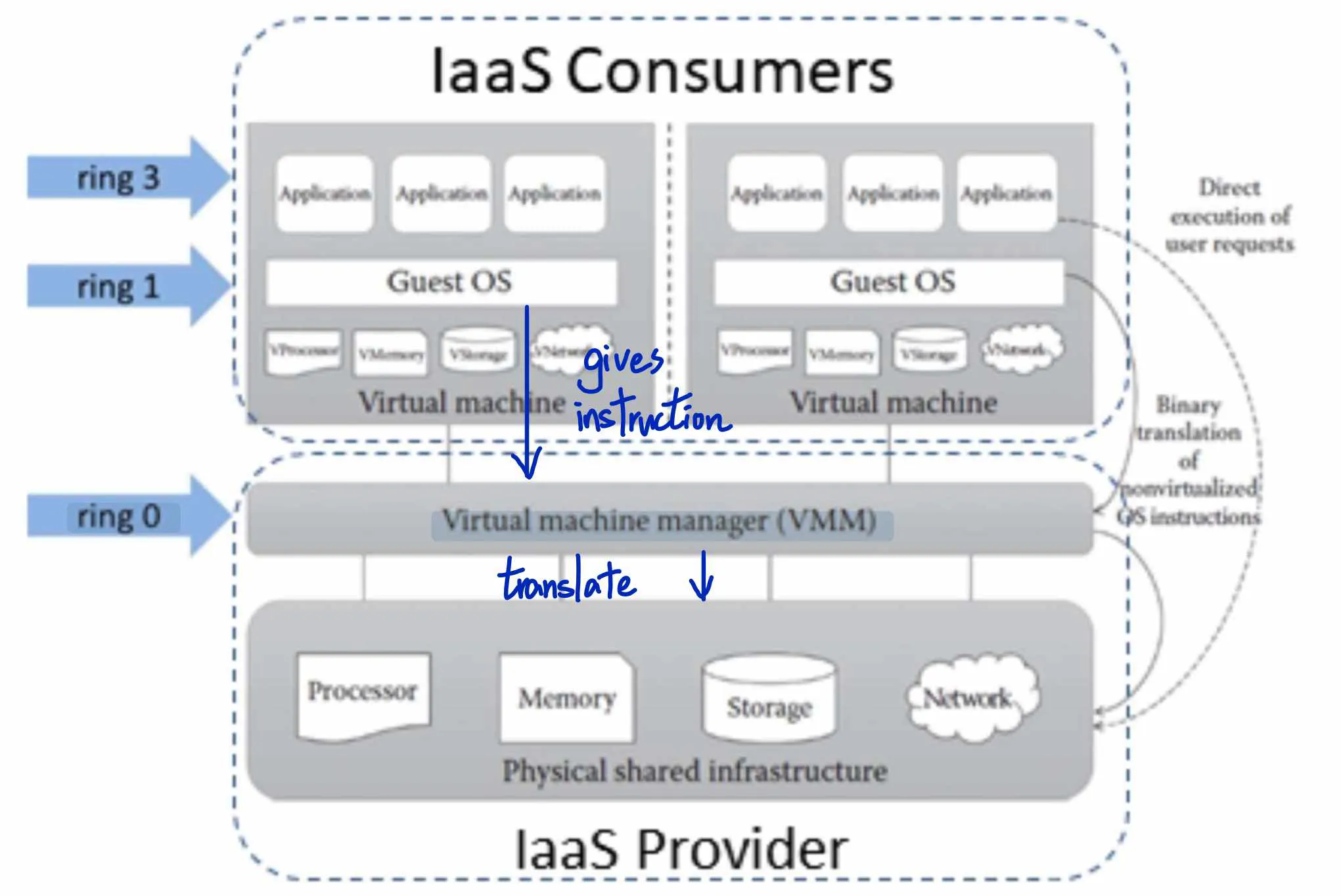
- Can run different guest OSs
- VMM translates guest OS instruction with binary translation
- Guest OS isn’t aware that it is virtualized
- Pros:
- isolation & security
- different OSs can run simultaneously
- guest OS can easily be migrated
- easy to install & use
- Cons:
- binary translation overhead
- need correct combination of hardware & software
Para Virtualization
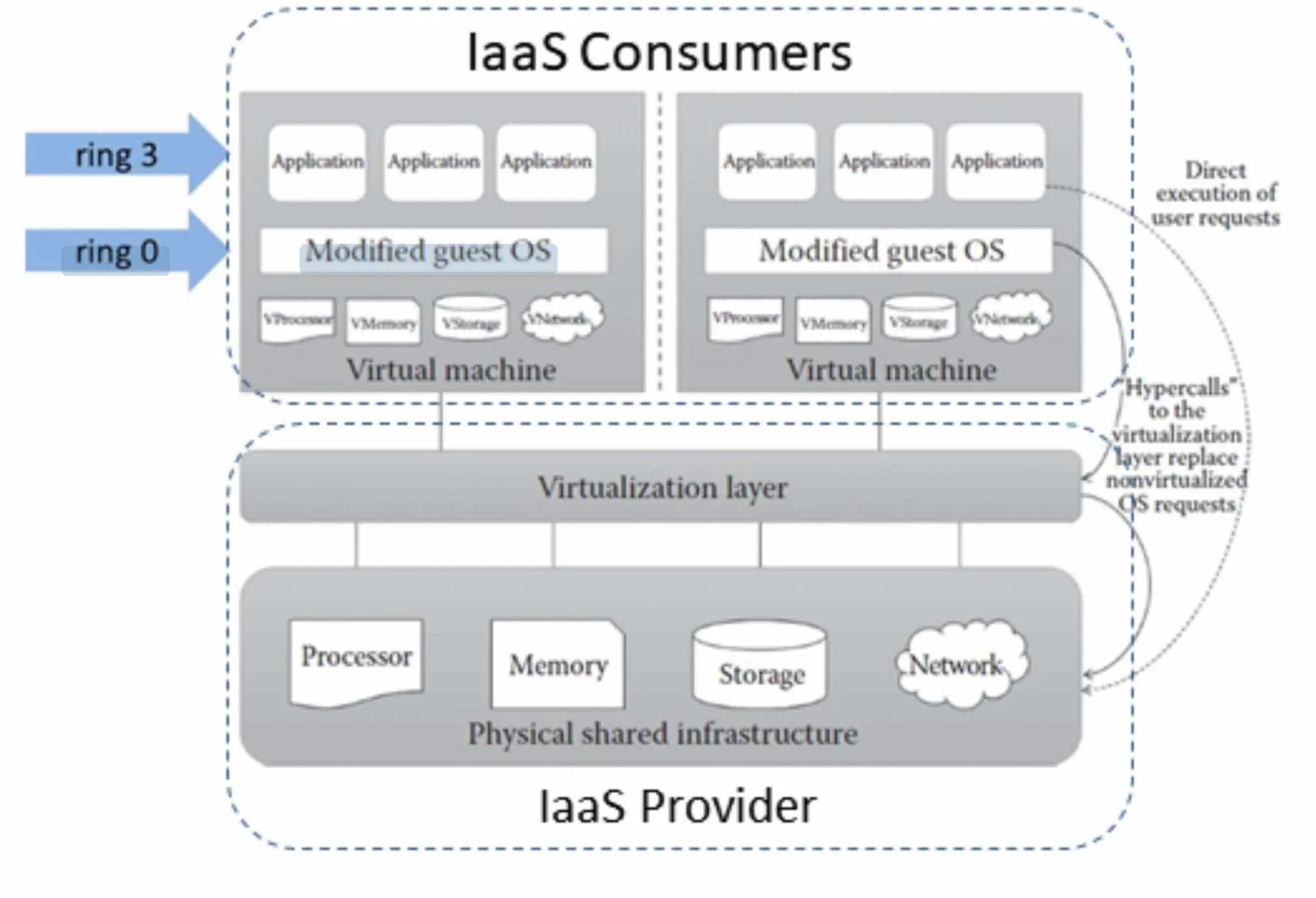
- Modified guest OS (ring 0) replaces OS requests with hypercalls: systems calls with privilege to communicate directly between OS and hypervisor without translation
- Guest OS knows it is running in a virtualized environment
- Pros:
- No need for binary translation
- No need for special hardware
- Cons:
- Overhead of guest OS kernel modifications
- Modified guest OS cannot migrate to run on physical hardware
- difficult to migrate to other hosts
Hardware-Assisted Virtualization (Hybrid)
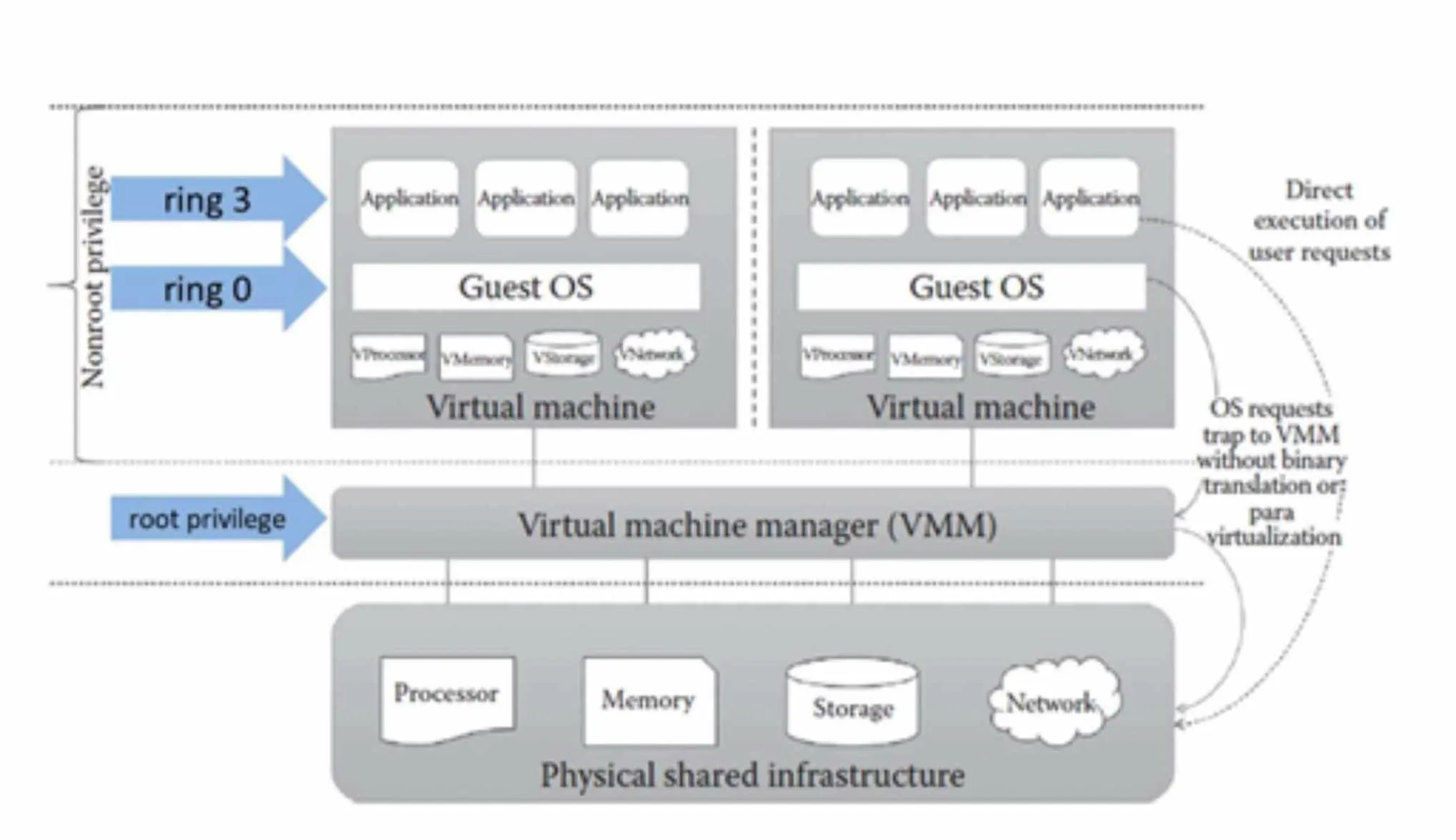
- Hardware (processor) extension supports virtualization
- OS requests directly trap the hypervisor: no need for binary translation & guest OS modification
- 「Trap」就是 CPU 偵測到 Guest OS 執行特權指令後,會自動轉交給 Hypervisor 處理的機制。
- VMM has the highest root privilege
Summary
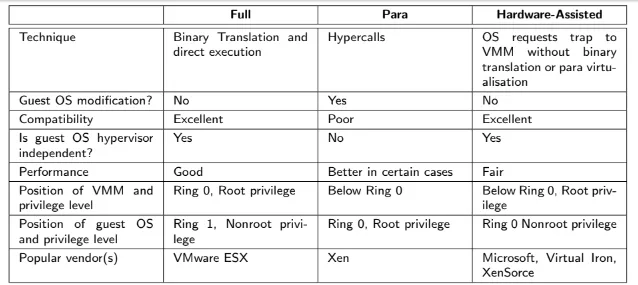
**Hypervisors (**Virtualization software)
Type 1: Bare Metal
- runs on physical infrastructure without help from host OS

Type 2: Hosted (Embedded) (more common)
- requires the help of host OS to communicate with infrastructure
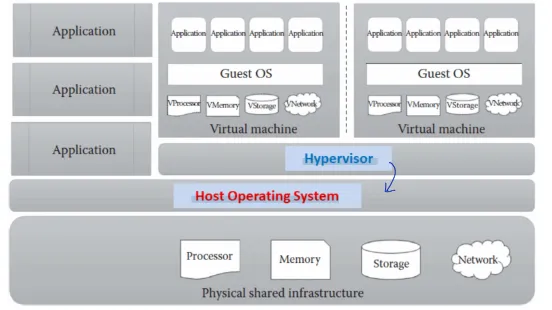
Containers
- shared host’s system kernel, lightweight
- Docker (PaaS)
- can run an application in an isolated environment (container)
- use namespaces to provide isolated workspace
- use a client-server architecture
- Docket daemon: building, running and distributing the docker containers, manages docker objects
- Docker client: primary way users interact with Docker (REST API)
- Docker Desktop: easy to install application for host OS
- Docker registries: stores images
- Images: read-only template with instructions for creating a Docker container
- Containers: runnable instance of an image
Multi-tenancy (多租戶)
- a single instance of software runs on a server and serves multiple tenants (users)
- from cloud consumers: dedicated instance of software with customized view
- Multi-tenancy vs. Virtualization
- Multi-tenancy: dedicated consumer instance of software
- Virtualization: abstraction of physical resources
- Multi-tenancy is possible because of virtualization
L6 Applications and Paradigms
Cloud applications focus mainly on enterprise computing
Ideal:
- app can partition its workload into tasks, run on n processing units to reduce execution time to (run in parallel)
- can be divided into many independent tasks
Not ideal:
- complex workflow & dependencies (e.g. high-performance computing)
- intense communication among instances
- workload cannot be partitioned
Challenges:
- Consumer: scale application to accommodate dynamic load, system failure, checkpoint
- Provider: manage a large number of systems, QoS guarantee
- Performance isolation, reliability (can be solved with redundancy, backup/ checkpoint), Latency/ Bandwidth fluctuations
- Data Logging: necessary, but need to limit it
Architecture
- Relies on Internet and web technology: high accessibility
- Use web technology as implementation medium & management interface
- Use web-based client-server architecture
- Three-tier architecture
- Presentation layer: the UI, sits on both the client and server side
- Application layer: the logic, sits on server side to receive client requests and generates web content based on application logic
- Data layer: persistent data stores, sits on server side, interact with application servers and the databases
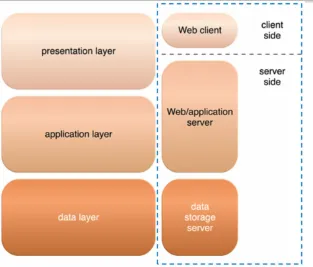
Simple Object Access Protocol (SOAP)
- application protocol for web applications
- common web service messaging format
- XML (structured), uses TCP or UDP as transport protocol
Representational State Transfer (REST)
- Software architecture for distributed hypermedia systems
- supports client communication with stateless servers
- uses JSON
- Platform & language independent
- Uniform interface, client-server decoupling
- Stateless (doesn’t record the states, so must include state info in the request)
- Cacheability
- Layered system architecture
- Code on demand (the return can be code and be run)
Web Services for Cloud Applications
Cloud services are distributed: single service request might require message passing between multiple servers
Accessed by different clients with different languages, so requires a standard interface for communication
Web service APIs implement a standard communication interface (REST API)
Cloud Application Development Models
IaaS
Web access to resources
Centralized physical resource management
Elastic services and dynamic scaling
Shared infrastructure
Preconfigured VMs
Metered services

PaaS
All in one: same IDE to develop, test, deploy, host
Web access to development platforms
Offline access for developers
Scalability
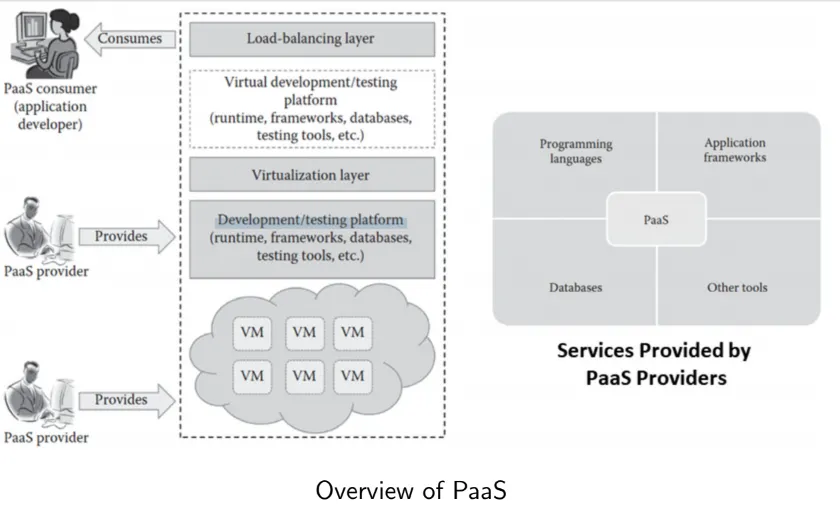
SaaS
Multi-tenanted applications
Web access
Centralized management of SaaS services
Scalability under varying loads
High availability
API integration with other software

Example: Setting up a Blog
SaaS (Easiest)
- App is located on the cloud
- Web browser to access
- Built on top of multi-tiered PaaS & IaaS
- Simply access a server with Wordpress installed and configured
- Set up a new blog
PaaS (More customization)
- Consumer:
- Creates software using tools & libraries from PaaS provider
- Controls software deployment & configuration
- Provider:
- Installs & maintains software, libraries & middleware
- API for consumers
- Provides integrated services of scalability, maintenance & versioning
- Access a system with Linux, Apache, MySQL, and PHP
- Install and configure Wordpress blog engine
- Set up a new blog
IaaS (Most complex)
- Consumers need to set everything up
- Create a compute instance running Linux
- Install and configure Apache, MySQL, and PHP
- Install and configure Wordpress blog engine
- Set up a new blog

Function as a Service (FaaS)
- scalable, reactive, event-driven applications
- Functions as unit of deployment
- application in divided into smaller, single-purpose (Lambda) functions
- event triggers a lambda function
- no idle capacity
- lambda is stateless
- build applications without the need to provision or manage servers
- only pays when code is executing
- no VMs
- vendor provides provision-free scalability
- functions should perform only one action (small)
- functions should be self-contained (should not call other functions)
- use as few libraries as possible (for faster execution)
- e.g. app backends, chatbot, real-time data processing
FaaS vs. PaaS vs. others
- provision time is much lower
- none on-going administration
- inherently scaled
- no capacity planning needed (built in, provider will do)
- stateless
- FaaS provider manages all maintenance
- high availability (functions running on provider’s servers)
- resource utilization is excellent
- has resource limits (keep function small/ lightweight)
Lambda Function

- Lambda function: app logic
- Steps:
- Create lambda service
- logic, configuration, event
- Deploy service created
- Invoke/ test your service
- Create lambda service
MapReduce
- supports arbitrarily divisible workload
- distributed computing on large data sets on multiple machines (100 GB, TB, PB)
- SPMD (Same program multiple data), a master instance partitions the data and gathers the partial results
- Split data into blocks and assign each block to an instance/ process for parallel execution
- intermediate output <key, value> pairs
- Merge partial results produced by individual instances after all instances have completed execution (aggregate)
- Split data into blocks and assign each block to an instance/ process for parallel execution
- Example: Word counting
- Map: data is partitioned into 4 smaller data files ⇒ split 0 to split 3
- Shuffle:
- each smaller data split is evaluated by a map task
- a map produces data (partition) or intermediate results that belongs to different reduce tasks
- Merge and sort: partitions on arriving at a reduce task are merged in to one file and sorted to produce a sorted file
- Reduce: evaluates the sorted file to produce the final result
- Map workers run in parallel
- each has its own dataset
- each creates intermediate local values from each input dataset
- Reduce workers run in parallel
- may reduce intermediate ata

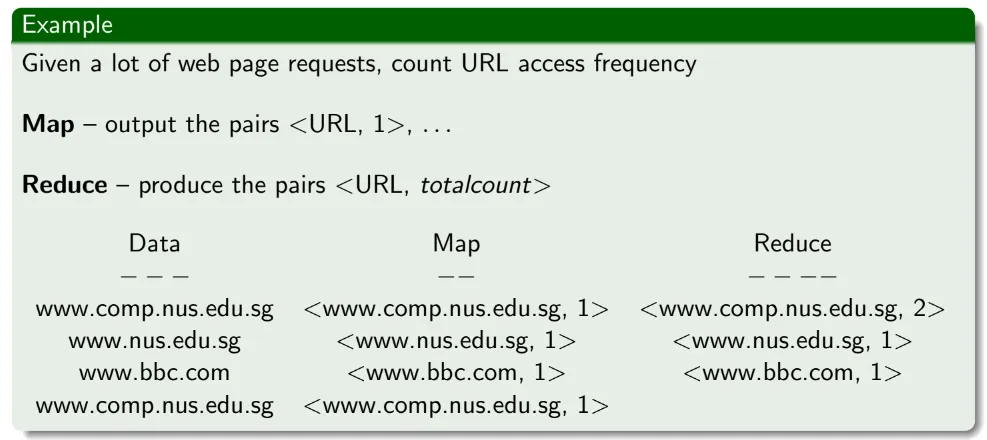
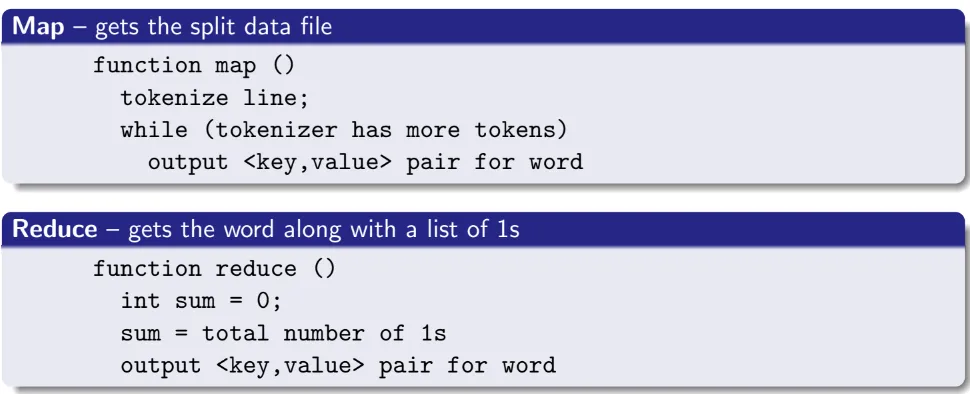
Hadoop
- Google MapReduce: closed source
- Hadoop MapReduce: open source
- Hadoop Distributed File System (HDFS)
- HDFS mimics Google File System (GFS)
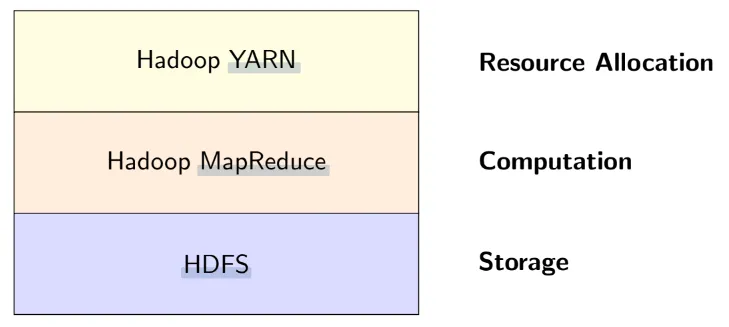
L7 Example Applications
K-Means Clusters
- Algorithm to cluster objects based on attributes into groups,
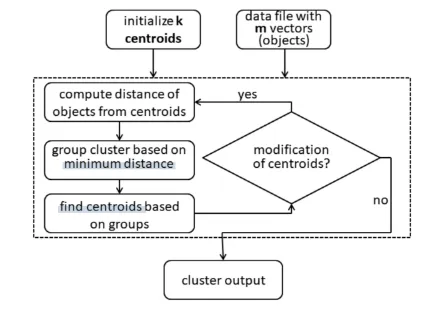
Steps:
- Initialize
- Iterate (Can work in parallel)
- compute distance and form clusters
- recompute centroids
- Output
Map phase
- Input Key-Value pair (pre-processing)
Key: ID of a user
Value: vector of attributed of that user (e.g. followers, followees)
log to deal with outliers (smooth the result)

- Compute distance between input point and all the previously obtained centroid of clusters
- Find the cluster with the minimum distance (map point to cluster)
- Add the input point into the cluster with the minimum distance
- Intermediate output: <clusters, data points belonging to that cluster> pairs
Reduce phase
- receive all the points belonging to a particular cluster
- Compute new centroid
- Output Key-Value pair
Key: ID of a cluster
Value: vector of centroid of the cluster and the number of points inside the cluster (or list of points)

K-Means Implementation
- Storage (AWS S3)
- MapReduce Engine (AWS EMR)
Video-sharing SaaS Cloud Application
- User can upload, stream, download videos
- Challenges:
- Videos are uploaded in different formats, so need to convert them into streaming format ⇒ CPU intensive
- Upload of videos and streaming videos to multiple users ⇒ I/O intensive
Upload Process
- Uses a web browser
- Need interface (web server EC2), storage (S3), balancing (load balancer, auto scaling, message passing, database, etc.)
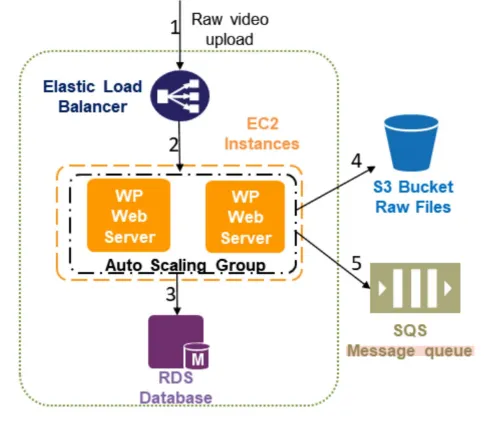
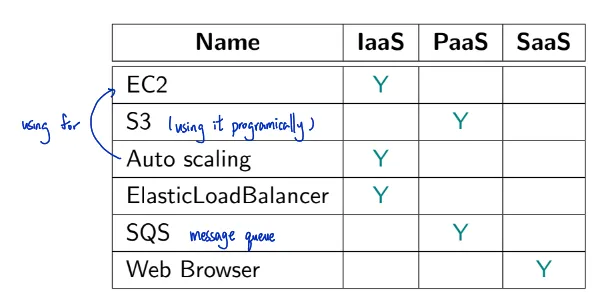
Encoding Process
- Need video encoder (ffmpeg, an open-source project), server to manage the encoding (EC2), storage to store encoded videos (S3), balancing
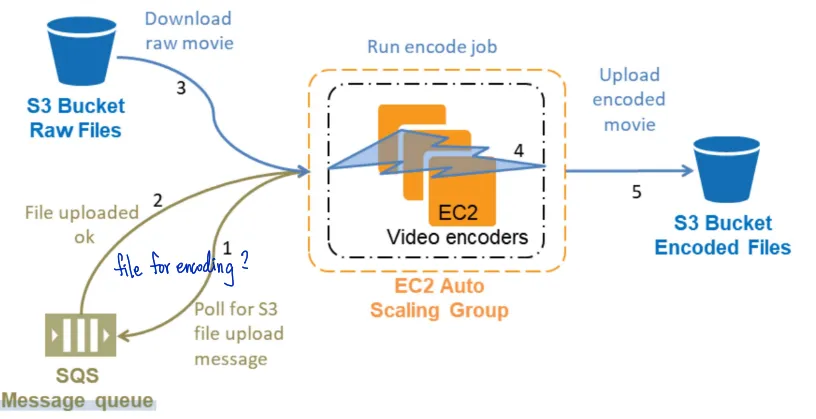
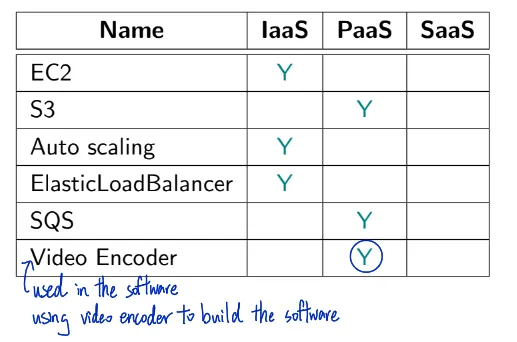
Streaming Process
- Uses a web browser
- Need video streamer (Amazon CloudFront Streamer, a web service that speed up content distribution of static and dynamic web content), storage for encoded videos (S3), balancing

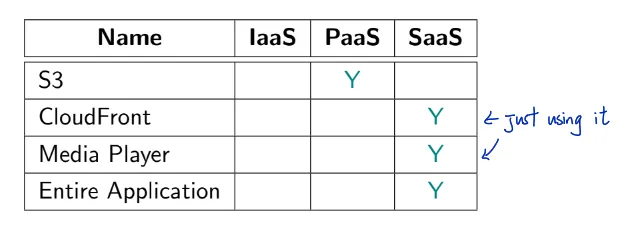
Performance & Scaling
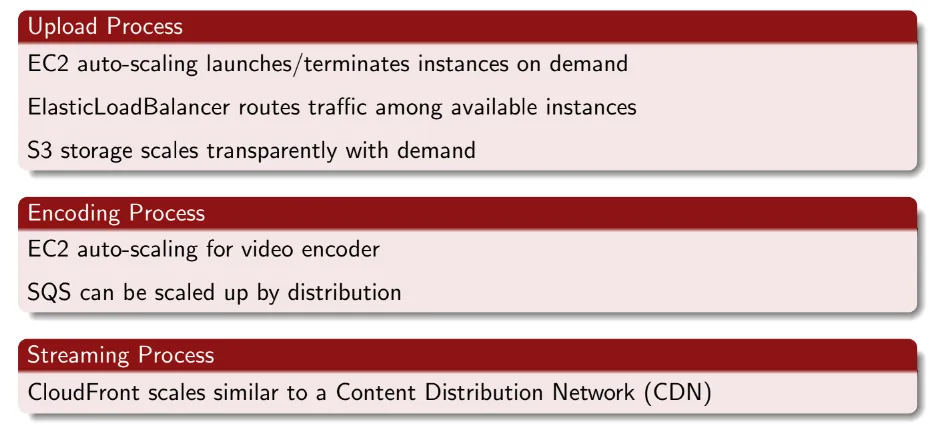
Pricing
- cloud vs. on-premise
- different cloud providers
- different offerings from the same provider (different EC2 instances…)

L8 Cloud Service Development
- SaaS: change the way software is delivered
- Usage-based billing, high scalability, ease of access, automated updates
- Challenges: Usability, availability, scalability, multi-tenancy, auto billing, security…
- PaaS: change the way SaaS software is developed
- Automates the process of deployment, testing and scaling: all on the same platform
SaaS vs. Traditional Software
- Pay-per-use
- Zero infrastructure: customers need not install the software
- less security issue (installing virus)
- Reduce business cost: One-to-many, some SaaS applications shared by multiple customers
- Automated updates: SaaS updates performed by provider
- SaaS is suitable when
- Customer require on-demand software
- Small company
- App with unpredictable and dynamic load (auto-scaling)
- SaaS is not suitable when
- Real-Time processing (don’t need to upload data)
- Data is confidential and data localization is needed
- SaaS key challenges
- Choosing correct multi-tenancy levels (multiple people accessing the same thing)
- Governance and security over user data (how to protect data)
Multi-tenancy levels
- Tradeoffs: Resource utilization/ multi-tenancy ↔ data governance
- Self-managed: they are not managed in the cloud but locally, either by organizations or individual
- SaaS with self-managed infrastructure & self-managed platform (low multi-tenancy, high data governance)
- Multi-tenancy: SaaS layer only
- Provider has full control over infrastructure and platform → user data is more controlled
- Cost & overhead of maintaining platform and infrastructure → lower resource utilization
- SaaS with self-managed infrastructure
- Deployed on on-premise infrastructure
- Full governance over user data
- E.g. community deployment model
- SaaS with self-managed platform
- Used when does not require more data governance
- Higher infrastructure resource utilization
- Overheads of maintaining platform
- SaaS with cloud-enabled IaaS & PaaS (high multi-tenancy, low data governance)
- Shared everything
- High SaaS scalability through dynamic scaling by IaaS and PaaS providers
- High availability: backup & recovery by providers
- Little to no governance over user data → cross tenant attacks across all layers (DDOS)
- PaaS provides a platform to mitigate the issue of traditional software development: use a platform for testing, deployment, scaling and maintenance
Cloud-Aware Software Development Using PaaS
- Requirement analysis (who’s the user, how/why)
- Multitenant architecture
- Dynamic scaling & availability
- Database design: database-level multi-tenancy
- SaaS development using PaaS
- Monitoring and SLA maintenance
Deployment model
- Public PaaS: low maintenance overhead but higher security threats
- Private PaaS: high maintenance but moderate security threats
- Higher level of multi-tenancy → higher resource utilization, lower security of data
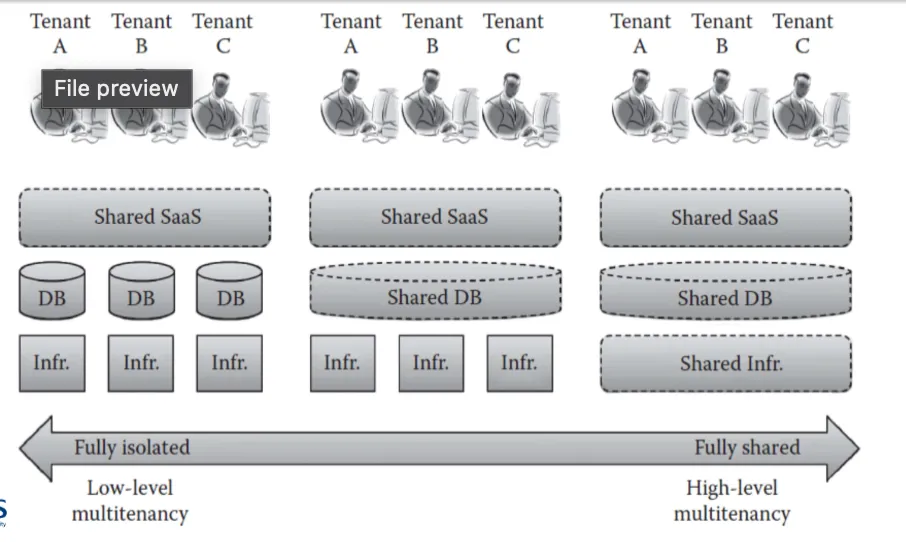
Dynamic Scaling
maintain same performance on unpredictable load
- Software load balancers: user requests are distributed across different application and database servers
- Hardware load balancers: loads are distributed across different virtual machines when there is a need for more computing power
- High availability: multiple replica copies of VM and DB
- Recovery time: replica should be near customer location
Database Design
Diverse data types of SaaS applications → use a NoSQL database to achieve scalability and availability at the database level
- Options:
- Sharing the database instance (所有租戶共用同一個資料庫實例,包括儲存空間、資源等,可能在不同的資料表中儲存資料)
- Sharing the database table (所有租戶共用同一個資料表,可能透過 tenant_id 欄位來做區分)
- Sharing the database schema (每個租戶有自己的資料表或資料庫 schema,但結構相同)
SaaS Development Using PaaS
SaaS developer/provider: PaaS tools allow developer to develop the SaaS app online and deploy on provider’s infrastructure
SaaS consumer: access SaaS using web UI provided by SaaS provider
Things to consider
- UI design to support multiple kinds of devices
- Identify users and tenants: role based access control
- Performance monitoring tools
- Managing users
- Self-service sign-up for users
- Usage statistics & bill calculation
- Monitoring SLA maintenance
- Service-level agreement
- Monitoring: tenant behavior, failure, security attacks, SLA violations
- Updates: should not affect SaaS service, frequent automated updates to provide consumers with latest version
L9 Pricing Models and TCO
- TCO: Total Cost of Ownership(擁有一個datacenter要花多少錢)
- move to the cloud to save $
Pricing
- Provider: How do providers price cloud resources
- Consumers: What is the cost of using cloud resources
Pricing Models
- Price: unit cost of using cloud resources
- e.g. based on time, number of transaction
- charge by per hour, minutes…
- Factors(考量因素): overhead in design, development, deployment and operation of cloud services and other IT resource
- Can reduce expenses via IT resource sharing (multi-tenancy) and optimization
- Market competition and regulatory requirements
- Variables
- cost metrics: on-demand (pay-per-use) or reserved allocation (upfront fee + discounted hourly rate)
- IaaS: pricing based on resource allocation and usage
- PaaS pricing based on software configurations, tools and licensing fees
- SaaS: pricing based on number of application modules in the subscription, cloud service consumers, transactions
- SaaS pricing models
- Integrated pricing: (common)
- consumer pays SaaS provider
- SaaS provider pays IaaS provider
- Separate pricing:
- consumer pays SaaS provider for SaaS service
- consumer pays IaaS provider for hosting SaaS service
- complicated for customers
- Example: AWS pricing
- Charges differ across region
- On-demand: based on usage of time
- for flexible demands (spark)
- e.g. shopping app, concert app
- Reserved: onetime upfront cost + pay as you go (lower than on-demand)
- for access overtime (constant workload)
- 需要預付費用 (long-term)
- e.g. internal system, corporate official website
- Spot: bid for unused capacity at a lower price than on-demand
- for jobs not time critical, lower cost
- e.g. machine learning jobs, data batch processing
- Dedicated: instance runs in a VPC on hardware dedicated to single customer
- physically isolated at the host hardware level
- data protection is important
- Integrated pricing: (common)
- Cost metrics
- compare on-premise (TCO) vs. cloud-based provisioning
- Business costs = capital expenses + operational expenses
- Up-front costs 一開始就要支付的$
- capital expenses (Capex)
- initial fund IT resources
- on-premise is high (hardware, software, deployment costs)
- cloud-based is low (labour cost for setting up cloud environment)
- On-going costs
- operational expenses (Opex)
- run and maintain IT resources (license fee, electricity, maintenance)
- on-premise is high
- Addition costs
- cost of capital: cost incurred to raise funds
- 公司為了籌集資金所必須付出的代價。簡單來說,就是公司為了拿到錢(不論是從股東、銀行、還是投資人那裡),需要付出多少代價(利息、股息、報酬期望)。
- if high, should go to cloud-based
- Sunk costs: prior investment on existing IT resources
- if high, cloud-based less appealing
- already own/ invested $ in local infrastructure
- Integration costs: effort needed to inter-operate IT resources on new environment
- 把現有的 IT 系統、資料庫、應用程式等,搬到新環境(像雲端)時,所需要花費的時間、人力、技術與金錢成本。
- if high, cloud-based less appealing
- Locked-in costs: movement from one cloud provider to another
- 從一個雲端供應商(例如 AWS)轉移到另一個供應商(例如 GCP 或 Azure)所需付出的代價。
- if high, cloud-based less appealing
- cost of capital: cost incurred to raise funds
- Up-front costs 一開始就要支付的$
- Cloud usage cost metrics
- Network usage (data transfer): inbound, outbound, intra-cloud network traffic
- Applicable to IaaS, PaaS, SaaS
- Inter-cloud: data replication, sync (跨雲的流量)
- Intra-cloud: some providers may not charge for it(雲內部的流量)
- Server usage (compute): CPU, RAM, dedicated storage…
- On-demand: par-per-usage fee short-term
- Reserved: upfront cost for reservation, long-term
- Cloud storage device (storage)
- On-demand storage space: size of storage space
- I/O data transferred metric
- Cloud service (service): subscription duration, # users, # transactions
- Network usage (data transfer): inbound, outbound, intra-cloud network traffic
- Total cost of ownership of a datacenter (TCO)
- Costs: capital expenses (Capex) + operational expenses (Opex)
- Capex: upfront investment
- construction cost of datacenter, purchase price of servers
- Opex: recurring cost of running datacenter
- electricity costs, repairs, maintenance, salaries
- TCO = datacenter depreciation (折舊、成本分攤)+ datacenter Opex + server depreciation + server Opex
- depreciation: 資產隨著時間使用、老化、貶值而產生的成本分攤
- Understand the needs
- e.g.
Case A: high-end servers (Capex heavy)

Case B: Lower-cost, high-power servers (Opex more)
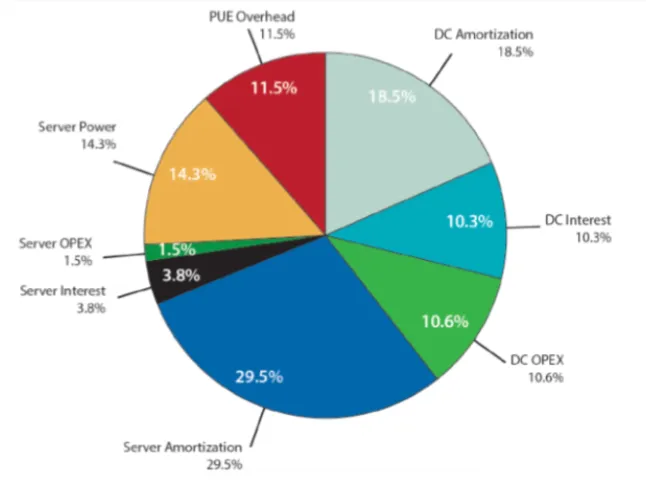
Case C: Case B with 50% datacenter utilization (low utilization rate)

Summary

L10
Cloud Native: how we can redesign the application to take advantage of the cloud
- containers, microservices, CI/CD, DevOps …etc
Microservice
- independently deployable services modeled around a business domain
- small & lightweight
- communicate with one another via APIs
- faster startup time, independent deployability/scalability
- loose coupling, high cohesion(凝聚力)
- Issue:
- synchronization of data
- scalability
- where do we host them? ⇒ container
Container
- to host microservices
- packages up code and all its dependencies
- standardized unit for development, deployment and distribution
Docker
- open source containerization platform
- build once run anywhere
Kubernetes
- container orchestration platform